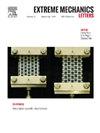量化破坏区和弹性释放区:对聚合物网络内在断裂的新认识
IF 4.5
3区 工程技术
Q2 MATERIALS SCIENCE, MULTIDISCIPLINARY
引用次数: 0
摘要
聚合物网络的固有断裂能描述了裂纹扩展所需的最小能量,不包括体内任何非弹性耗散。最近的研究表明,固有断裂能来自两种不同的贡献。第一个贡献Γf是聚合物链沿裂纹路径破裂所耗散的能量,这些链构成了破坏区。第二个贡献Γe是由断裂链附近的聚合物链松弛释放的弹性能量,这些链构成弹性释放区。虽然现有的模型可以成功地预测聚合物网络的内在断裂能,但两种内在断裂能的量化贡献仍然难以捉摸。在这里,我们利用聚丙烯酰胺水凝胶进行了一系列的纯剪切试验来测量断裂能。本研究通过改变纯剪切试样的高度来精确控制实际弹性释放区的大小。基于断裂表观能与试样高度的关系,首次对聚丙烯酰胺水凝胶的Γf和Γe进行了定量鉴定。此外,我们改进的环开模型的开发代表了该领域的重大进步。该模型考虑了聚合物网络的缺陷,并纳入了具有明确物理意义的参数,与我们的实验结果非常吻合。在此基础上,提出了一种确定破坏区大小的新方法。此外,我们的研究结果为通过各种测试方法获得的裂缝能测量结果的差异提供了见解。该研究增强了对聚合物网络内部断裂机制的理解,并为设计更坚韧的聚合物材料奠定了基础。本文章由计算机程序翻译,如有差异,请以英文原文为准。
Quantify the failure zone and elastic release zone: A new insight into intrinsic fracture of polymer networks
The intrinsic fracture energy of polymer networks describes the minimum energy required for crack propagation, excluding any inelastic dissipation within the bulk. Recent studies have demonstrated that the intrinsic fracture energy arises from two distinct contributions. The first contribution is the energy dissipated by the rupture of polymer chains along the crack path, where these chains constitute the failure zone. The second contribution is the elastic energy released from the relaxation of polymer chains adjacent to the broken chains, where these chains constitute the elastic release zone. While existing models could predict the intrinsic fracture energy of polymer networks successfully, a quantification of the two intrinsic fracture energy contributions remains elusive. Here, utilizing polyacrylamide hydrogel, we conduct a series of pure shear tests to measure the fracture energy. The size of real elastic release zone is precisely controlled in this study by varying the heights of pure shear samples. Then, for the first time, and of the polyacrylamide hydrogel are quantitatively identified based on the relationship between the apparent fracture energy and the height of sample. Moreover, our development of a modified loop-opening model represents a significant advancement in the field. This model accounts for polymer network imperfections and incorporates parameters with clear physical meanings, aligning remarkably well with our experimental findings. Based on our model, we propose a novel method for determining the size of failure zone. Furthermore, our findings offer insights into the discrepancies observed in fracture energy measurements obtained through various testing methods. This study enhances the understanding of intrinsic fracture mechanisms within polymer networks and lays the groundwork for the design of tougher polymer materials.
求助全文
通过发布文献求助,成功后即可免费获取论文全文。
去求助
来源期刊

Extreme Mechanics Letters
Engineering-Mechanics of Materials
CiteScore
9.20
自引率
4.30%
发文量
179
审稿时长
45 days
期刊介绍:
Extreme Mechanics Letters (EML) enables rapid communication of research that highlights the role of mechanics in multi-disciplinary areas across materials science, physics, chemistry, biology, medicine and engineering. Emphasis is on the impact, depth and originality of new concepts, methods and observations at the forefront of applied sciences.
 求助内容:
求助内容: 应助结果提醒方式:
应助结果提醒方式:


